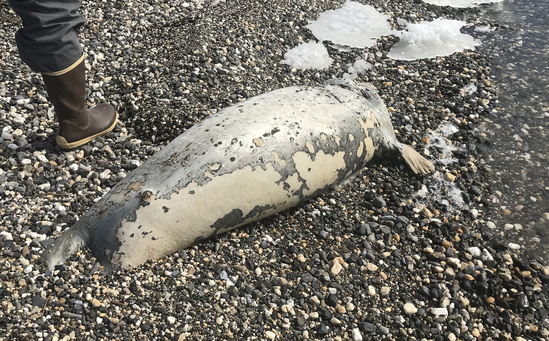A dead seal found near Kotlik, Alaska. Image: Harold Okitkun
A mysterious string of seal deaths along an Alaskan coastline has triggered a federal investigation.The carcasses of at least 60 ice seals—bearded, ringed, and spotted seals—have been discovered near the Arctic’s Bering and Chukchi seas on Alaska’s western coast, the National Oceanic and Atmospheric Administration (NOAA) announced in a press release on Wednesday.The agency received multiple reports of dead seals on Monday in Norton Sound, a Bering Sea inlet and subsistence hunting area for Indigenous communities. A hunter from the local city of Kotlik found 18 carcasses along 11 miles of shoreline, and “dozens” more across the bay on Stuart Island, NOAA said.Further north, a biologist with the National Park Service encountered six dead seals along the Chukchi shoreline between Kotzebue Airport and Sadie Creek, NOAA added. Members of the public also reported 30 carcasses up the coast between Kivalina and Point Hope. These mortalities followed the discovery of eight dead young bearded seals on St. Lawrence Island in the Bering Sea in early May.“As we received most of our reports of these dead seals on Monday, and they are located in a very remote region of Alaska, our marine mammal experts have not yet been on the scene where these dead seals are located,” a spokesperson for NOAA Fisheries Alaska Region told Motherboard in an email.The agency said that some of the seals exhibited hair loss, but it’s unclear whether this was an effect of decomposition or abnormal molting.“We do not know what has caused these seals to die, nor have we ruled anything out. We are early in our investigation,” the spokesperson added.NOAA likened these symptoms to an event that killed 233 seals between 2011 and 2016 in northern Alaska. At least 657 dead and live seals presented with hair loss and lesions that were ultimately blamed on an “abnormality of the molt.” The agency declared it an Unusual Mortality Event, defined as “a stranding that is unexpected; involves a significant die-off of any marine mammal population; and demands immediate response.”At the time, coastal communities worried that diseases could spread from seals to humans. But NOAA found no signs of infection, nor any reports of transference to humans.Seals are an “essential resource for Alaska Native communities” and “food safety is a major concern,” the agency noted on Wednesday. NOAA says it is working with local groups and hunters to address concerns about contamination, as well as reports that seals “are unusually thin this year.”NOAA is asking anyone who sees a dead seal in the area to report it to a number of hotlines.
These mortalities followed the discovery of eight dead young bearded seals on St. Lawrence Island in the Bering Sea in early May.“As we received most of our reports of these dead seals on Monday, and they are located in a very remote region of Alaska, our marine mammal experts have not yet been on the scene where these dead seals are located,” a spokesperson for NOAA Fisheries Alaska Region told Motherboard in an email.The agency said that some of the seals exhibited hair loss, but it’s unclear whether this was an effect of decomposition or abnormal molting.“We do not know what has caused these seals to die, nor have we ruled anything out. We are early in our investigation,” the spokesperson added.NOAA likened these symptoms to an event that killed 233 seals between 2011 and 2016 in northern Alaska. At least 657 dead and live seals presented with hair loss and lesions that were ultimately blamed on an “abnormality of the molt.” The agency declared it an Unusual Mortality Event, defined as “a stranding that is unexpected; involves a significant die-off of any marine mammal population; and demands immediate response.”At the time, coastal communities worried that diseases could spread from seals to humans. But NOAA found no signs of infection, nor any reports of transference to humans.Seals are an “essential resource for Alaska Native communities” and “food safety is a major concern,” the agency noted on Wednesday. NOAA says it is working with local groups and hunters to address concerns about contamination, as well as reports that seals “are unusually thin this year.”NOAA is asking anyone who sees a dead seal in the area to report it to a number of hotlines.
Advertisement

